Furniture tipping is a known safety hazard in homes so it is an important topic for interior designers. It is a big part of a designer’s job to build safety and security into their designs. There is also the subject of product liability for designers because sometimes injuries in the home occur due to unsafe designs. A good interior designer does extensive research into the stability of structures, walls, floors, and the placement of furniture. This is an excellent reason to consult with professionals to avoid furniture tipping injuries in your home.
The Furniture Tipping Statistics

A Few Quick Tips
The statistics shown in this infographic are definitely cause for concern. However, the good news is, there are steps you can take to prevent accidents from furniture tipping. Here are a few quick tips we gleaned from the infographic below:
- Walk around your home to check all your televisions for weak bases. Be sure to securely relocate or replace them when needed.
- Install drawer stops in the chest of drawers so that it will not be used as a ladder for small children.
- Keep your electrical cords and cables organized, bundled, and out of the reach of children.
- Mount flat screens securely to your walls whenever possible to prevent toppling.
Inspect Your Walls
Pay close attention to the walls surrounding your furniture as well. Ensure that the loads on your walls support what you have hanging on them, such as large hanging pictures or televisions. Securely attach bookshelves to the walls to avoid furniture tipping.
Round the Corners
Avoid sharp corners on your counters and furniture whether wood, glass, or stone. Opt for rounded corners instead whenever possible. Another suggestion is to replace square tables with round tables. Or instead, add a round tabletop to your existing square table. Those are easy fixes, but please consult with a mason if you want your kitchen countertop corners to go from sharp to rounded.
In the following infographic, Lauters conducted a survey that shows statistically the dangers lurking in many of our homes right under our noses.
Other Posts You Might Enjoy:
Antique Furniture Moving; 3 Things You Need to Know
Furniture Tips for Proper Care and Maintenance






